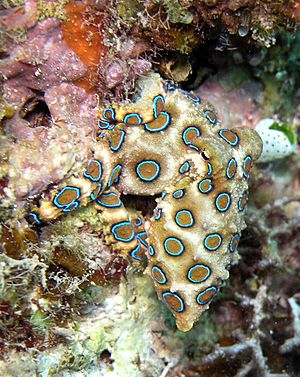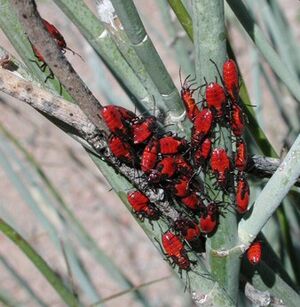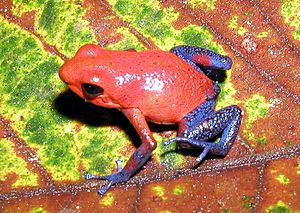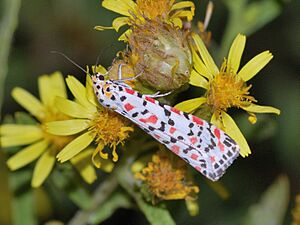Warning colouration facts for kids
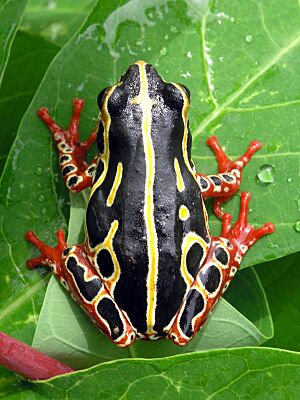
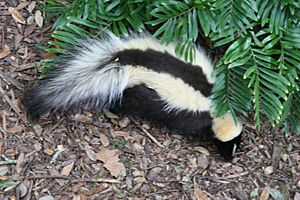
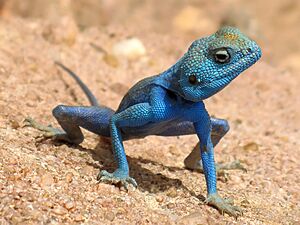
Warning colouration (also called aposematism) is how animals tell other animals that they are dangerous or taste bad. It is the opposite of camouflage, which helps animals hide. Warning colours are often bright combinations of red, yellow, black, and white.
In 1889, Alfred Russel Wallace, a British naturalist, explained it well. He said that animals with warning colours have special defenses like stings or poison. Because they taste bad or are dangerous, other animals usually leave them alone.
It is important for these animals not to be mistaken for easy prey. If they were, they might get hurt before their enemies realized the danger. So, they need a clear signal or "danger flag" to warn away possible attackers.
Wallace thought that birds and other predators would avoid brightly coloured prey. Later studies proved he was right.
Animals with warning colours often move slowly and are easy to see. This slow movement and being out in the open helps them show off their defenses. Along with their bright colours and behaviour, they often have a bad smell from their chemical weapons. The grasshopper Aularches miliaris is a good example.
Some caterpillars that taste bad have thick, tough skin. This helps them survive if a young bird tries to peck them. When a bird pecks, a disgusting fluid comes out from special glands on the caterpillar's back. The caterpillar often survives, and the young bird learns a lesson it won't forget. This shows that warning colours really do stop predators.
Some individual animals might get hurt or even die while predators learn about the link between colour and bad taste. However, if warning costs less than hiding, the animal benefits. Also, warning traits like bright colours can have other uses. For example, the patterns might help animals of the same species recognize each other for mating.
Warning colouration is the basis for two types of Mimicry: Müllerian mimicry and Batesian mimicry.
Contents
Animals That Eat Toxic Prey
Some predators can eat animals that are toxic. Studies show that these predators often pay a price for being able to resist the toxins.
The Rough-skinned newt is a toxic animal that shows its warning colour by displaying its belly. In many places where the newt lives, the common garter snake (Thamnophis sirtalis) is resistant to its toxin. In some groups of garter snakes, they can successfully hunt and eat these newts. Toxin-resistant garter snakes are the only known animals that can eat these newts and survive.
The snake's resistance to the toxin has led to a special kind of selection. This selection favors newts that produce even stronger toxins. As newts become more toxic, this creates pressure for snakes to develop even greater resistance. The cost for these snakes is that their digestion and body metabolism are slower than other related species. Snakes that are very resistant move more slowly than snakes with little or no resistance.
This is an example of co-evolution. This ongoing cycle between a predator and prey, where they both evolve in response to each other, is sometimes called an evolutionary arms race. In this case, it means the newts produce much more toxin than needed to kill any other predator.
Other Uses for Bright Colours
Animals can have bright colours for reasons other than warning. The most common reasons are:
- Identification: To help find a mate, often as a secondary sex characteristic.
- Temperature regulation: To help control their body temperature.
- Camouflage: To blend in with unusual backgrounds.
However, the bright colours used for these purposes usually look different from the typical warning patterns and colours.
Colours with Unknown Purpose
The purpose of the colours of many species is not yet known. This is often because their life habits have not been studied enough. Also, not enough field tests have been done. One example is the amazing moth Utetheisa pulchella, known as the Crimson Speckled Moth. It is found near the plant Dittrichia viscosa, which has a slightly unpleasant smell. This suggests the moth might have warning colouration, but it's not certain. A related species, Utetheisa ornatrix, which eats other plants, is known to release alkaloids to deter predators.
Images for kids
-
The bright colours of this granular poison frog signal a warning to predators about its toxicity.
-
A skunk, Mephitis mephitis, showing its powerful defenses. It raises its tail and displays its warning colouration, with scent glands near the tail.
-
There is evidence that nudibranchs like Phyllidia varicosa use warning colours.
-
The bright colours of crown-of-thorns starfish spines might warn of strong toxins inside.
-
Iridescent blue rings on the mantles of the venomous octopus Hapalochlaena lunulata are thought by some to be warning colours.
-
The first edition of Edward Bagnall Poulton's The Colours of Animals, from 1890. This book introduced new terms for animal colouration, including "aposematic."
-
A model (to be copied), the venomous and truly aposematic coral snake.
-
The harmless red milk snake, which is a Batesian mimic of the coral snake.
See also
 In Spanish: Aposematismo para niños
In Spanish: Aposematismo para niños


